Exploring Andrea Bocelli's Impactful Performances
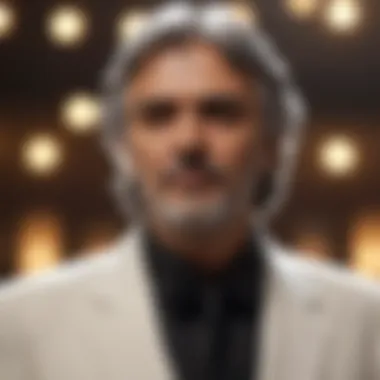
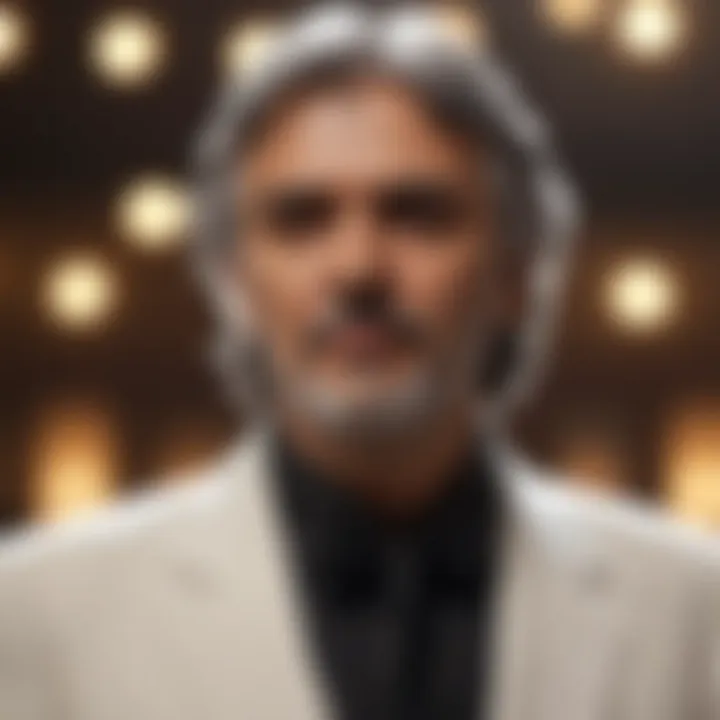
Intro
Andrea Bocelli stands as one of the most captivating and influential figures in the realm of music today. His unique blend of classical and contemporary styles has not only made him a household name but has also reshaped the expectations and boundaries of vocal performance. This article will traverse through the various dimensions of Bocelli's artistic journey, emphasizing the elements that have contributed to his success on the world stage. We aim to delve into his biography, influences, standout concerts, and the deep emotional resonance that permeates his music, catering especially to music enthusiasts, aspiring musicians, and diligent students of the craft.
Artist Profile
Biography and Background
Born on September 22, 1958, in Lajatico, Italy, Andrea Bocelli displayed a penchant for music from a very young age despite facing numerous challenges. Losing his sight partially in a sports accident as a teenager did not deter his passion. He pursued music fervently, studying under the guidance of esteemed vocal coaches. Bocelli's early career was not an easy path but, with determination and hard work, he slowly climbed the ranks from performing in local bars to captivating audiences worldwide.
His breakthrough came in 1992 when he was spotted by renowned producer, Luciano Pavarotti. This chance encounter led to Bocelli’s first recording contract and a subsequent meteoric rise in his career. His debut album, Il Mare Calmo della Sera, released in 1994, was an immediate success, capturing both critical acclaim and popular appeal. Bocelli's distinct tenor voice, imbued with rich emotional depth, offered a refreshing take on traditional opera that resonated with a broader audience.
Major Influences and Inspirations
Bocelli’s artistry is deeply influenced by various musical genres, spanning classical, pop, and even rock. His inspirations include legendary figures like Enrico Caruso and the beloved Pavarotti. According to Bocelli himself, the power of emotion in music is the driving force behind his work. He cites artists like Frank Sinatra and the Beatles for their narrative lyrical styles, which have heavily shaped his understanding of song interpretation.
Moreover, his life experiences — including overcoming adversity and the influence of his family — play a significant role in his performances. Each note he sings carries an essence of vulnerability, making his renditions profoundly relatable. As a result, audiences from varying cultural backgrounds feel a connection to his music, establishing a global fan base.
Song Analysis
Theme and Lyrics Breakdown
Bocelli's music often encircles themes of love, longing, and resilience. Take, for example, "Con te partirò". The lyrics evoke a journey not just across distance but a deeper emotional voyage, resonating with anyone who has ever felt separated from a loved one.
The imagery he employs is vivid and poignant, encouraging listeners to reflect on their own experiences. His duet with Céline Dion on the English version, "Time to Say Goodbye", further amplifies this sentiment, marrying powerful vocal lines with evocative language that invites introspection.
Instrumentation and Composition
When analyzing the instrumentation in Bocelli's hits, one might notice a seamless integration of orchestral arrangements and modern instrumentation. The use of strings, particularly in tracks like "Nessun dorma" showcases the grandeur of the operatic tradition while embracing contemporary elements that appeal to a broader audience. The orchestration places Bocelli's voice at the forefront, allowing his lyrical prowess and emotional infusion to shine, creating a symbiotic relationship between the melody and the lyrics.
Through his performances, Bocelli often collaborates with gifted musicians and conductors, enhancing not only his stage presence but augmenting the overall musical experience. The blend of classical and pop genres often results in an enthralling soundscape that captivates diverse audiences, illustrating the evolving landscape of contemporary music.
"Andrea Bocelli has managed to capture a global audience by merging operatic techniques with emotional storytelling, crafting performances that transcend cultural barriers."
As we continue this analysis, we will explore further key concerts, collaborations, and the cultural significance of Bocelli’s work, painting a comprehensive picture of his contribution to the music landscape.
Preamble to Andrea Bocelli's Artistry
Andrea Bocelli stands as a towering figure in the world of music, bridging the often disparate realms of classical and contemporary genres. His unique artistry captivates audiences across the globe, making an in-depth analysis not just relevant but essential for understanding the impact of his performances. This section sets the foundation for exploring the various elements that contribute to Bocelli's celebrated career. From his early influences to his evolution as an artist, we will delve into the heartbeat of his musical journey.
Background and Early Life
Andrea Bocelli was born in Lajatico, a small town in Italy, on September 22, 1958. From a young age, he showed an affinity for music, yet his path was not only lined with melodic discoveries. Bocelli faced challenges, including a football accident that left him with diminished sight, shaping his determination and resilience.
His family encouraged his musical talent, and by the time he was a teenager, Bocelli was already performing in local bars and clubs. What’s fascinating here is that while many artists follow a straightforward journey from passion to profession, Bocelli’s early life was a tapestry woven with threads of perseverance and talent. His humble beginnings led him to study law at the University of Pisa, but the pull of music was irresistible. Eventually, he began to gain recognition, but not without grappling with the notion of whether to pursue a stable career or follow his heart. This internal conflict is something many aspiring musicians can relate to, making Bocelli's story particularly compelling.
Musical Influences and Inspirations
The breadth of Bocelli’s musical influences paints a vivid picture of his artistry. His love for the operatic and pop genres is not merely a blend; it’s an intricate fusion that reflects his diverse inspirations. Early on, he was profoundly affected by the works of Luciano Pavarotti and Franco Corelli, whose voices became his guiding lights. This admiration for operatic giants shaped his vocal style, focusing heavily on bel canto techniques.
However, Bocelli's tastes are not confined to the traditional realms. Elements from popular music, especially the works of artists like Frank Sinatra and, later, people like Ed Sheeran, colored his soundscape, demonstrating that Bocelli is not afraid to embrace a wide spectrum of influences. This eclectic approach allows him to resonate with a broad range of listeners. Like a chameleon, he adapts his style, creating bridges between the opera house and the concert stage.
To sum it up, understanding Bocelli’s background and musical inspirations offers crucial context as we move forward exploring his performances. It's this foundational narrative that not only informs his artistic choices but also enriches the audience’s experience with his music.
Vocal Techniques and Style
Vocal techniques and style are essential components of Andrea Bocelli's artistry. They are not just about producing sound but about conveying emotion and connecting with the audience. Bocelli's vocal approach intertwines classical traditions with modern sensibilities, creating a unique experience for listeners. The importance of this section lies in understanding how the nuances of his techniques contribute not only to his remarkable voice but also to his ability to bridge musical genres and reach audiences from diverse backgrounds.


Bel Canto: The Foundation of Bocelli's Technique
Bel canto, which translates to "beautiful singing," serves as the backbone of Andrea Bocelli's vocal technique. This style emphasizes the clarity of tone, seamless legato, and the ability to control dynamics effectively. Bocelli often utilizes breath control, enabling him to sustain long phrases with astonishing ease.
To appreciate his mastery of bel canto, one might listen to his rendition of "Nessun Dorma." The way he navigates the climactic high notes showcases not just power but a delicate beauty. This technique is important for several reasons:
- Emotional Range: Bel canto allows Bocelli to express a wide spectrum of emotions, from longing to exultation, drawing listeners into the narrative of each song.
- Technical Precision: His command of this style highlights his rigorous training and dedication to the art, appealing to classical music purists while attracting new fans.
- Versatility: The principles of bel canto enable him to cross genres, performing smoothly in opera, pop, and even sacred music, attracting an expansive audience base.
Fusion of Genres: Classical and Pop
Bocelli's ability to blend classical and pop forms a distinct hallmark of his performances. This fusion not only demonstrates his versatility as an artist but also signifies a shift in the music industry, where boundaries between genres blur increasingly. This unique style represents an evolution in music that appeals to a wider audience.
In many of his performances, he has shared the stage with pop icons such as Ed Sheeran and Ariana Grande, showcasing how effortlessly he adapts his classical techniques to modern pop sensibilities. The significance of this fusion includes:
- Broadening Reach: By merging genres, Bocelli captures the attention of both classical enthusiasts and pop listeners, thereby expanding his fanbase worldwide.
- Innovative Collaborations: Collaborations with contemporary artists often lead to innovative auditory experiences, keeping his music fresh and engaging.
- Cultural Conversations: This genre blending opens conversations about the relevance of classical music in today’s context, encouraging a new generation to explore the depth and beauty of operatic traditions.
Bocelli’s voice transcends mere technique; it creates a dialogue among musical genres, inviting listeners to experience the profound connections between them.
Signature Performances in Iconic Venues
The significance of Andrea Bocelli’s performances in iconic venues cannot be overstated. These settings not only serve as backdrops for his exceptional vocal artistry, but also enhance the emotional impact of his music. Performing in renowned locations, whether historic amphitheaters or contemporary concert halls, adds a layer of grandeur and a palpable atmosphere that engages the audience in profound ways.
When Bocelli takes to the stage in places like the ancient ruins of the Teatro del Silenzio in Tuscany, the connection between his music and the rich history of the locale is palpable. This synergy transforms each concert into more than just a performance – it becomes an experience steeped in culture and heritage. Here, the acoustics and the visual artistry work hand in hand, creating a memorable soundscape that resonates long after the final note.
Additionally, performing in diverse environments allows Bocelli to connect with a wide array of audience members. Fans may flock to venues that reflect their unique cultural backgrounds or personal memories, which enhances the communal experience that music provides. This sense of belonging is a fundamental aspect of why his concerts are so cherished.
The Teatro del Silenzio Experience
The Teatro del Silenzio serves as a striking example of Bocelli's unique concert settings. Nestled among the rolling hills of Lajatico, this open-air amphitheater is a testament to his roots, showcasing a perfect blend of nature and music. The surrounding landscapes form a breathtaking backdrop as twilight descends, setting the stage for a night filled with captivating performances.
In this space, Bocelli addresses an audience that often numbers in the thousands. His connection to the land, his birthplace, intensifies the emotional weight of his songs. Each performance becomes a celebration not only of his artistry but also of the community that nurtured it. As he sings poignant arias or beloved pop classics, the audience is swept away, united by the sheer magic of the occasion. They don’t just listen; they feel.
An interesting aspect of the Teatro del Silenzio is its exclusivity. It's more than an event; it’s a singular, yearly gathering that creates much anticipation among fans. The limited seating means that those lucky enough to attend often feel like part of an elite club, sharing a once-in-a-lifetime experience that binds them in a special way. This contributes significantly to the venue's allure, turning each concert into a pilgrimage for many devoted fans.
"Bocelli’s voice, combined with the setting in the open sky, makes for an experience unlike any other; it's as if the music is weaving itself into the very soil of Lajatico."
Memorable Concerts Around the World
Andrea Bocelli's performances extend beyond the enchanting hills of Tuscany, with memorable concerts held in prominent cities across the globe. Each event captures the unique flavor of its location while allowing the artist to showcase his versatility. For instance, a concert at New York’s Madison Square Garden might present a vastly different energy compared to an intimate gathering in a quaint European city.
Consider his performance at the ancient Roman Colosseum in 2010. The echoes of Bocelli’s voice against the ancient stones added a compelling dimension to the evening. It was not just a highlight of his career, but also a reminder of how music transcends time and place. The historic setting injected an air of majesty, resonating with audiences who traveled from afar to witness this remarkable fusion of past and present.
In contrast, Bocelli's recent concerts in Japan demonstrate his ability to connect with diverse cultures through music. The reception he receives in different countries also amplifies the significance of his performances. Audiences respond in ways that highlight their unique cultural backgrounds, enriching the concert experience.
Each city leaves an imprint on both Bocelli and his fans. As he performs, glancing over the crowd, it’s clear that he understands the importance of these interactions. Music is a universal language, and through his remarkable performances, Bocelli builds bridges that unite people from all walks of life.
Collaboration with Renowned Artists
The realm of music is often enriched by the symbiotic relationships formed between artists. Andrea Bocelli's career is a vivid tapestry woven with collaborations that have elevated his artistry and expanded his audience. Working with renowned artists has not only been a cornerstone of his musical journey but also a catalyst for innovation in his performances. Each duet and collaboration brings unique colors to his work, showcasing versatility and fostering connections across various music genres.
Duets that Shaped His Career
Duets have played an instrumental role in amplifying Bocelli's reach and showcasing his vocal prowess. His partnership with international stars has managed to bring classical music closer to mainstream culture. A notable example is his performance with British singer Sarah Brightman on "Time to Say Goodbye." Released in 1996, this duet became a defining moment for both artists, capturing the hearts of millions around the world. The crystalline clarity of Bocelli's tenor paired with Brightman's ethereal soprano created a hauntingly beautiful experience.
Another standout collaboration is with the multi-talented Ed Sheeran in 2017 on "Perfect Symphony." Sheeran's pop sensibility merged seamlessly with Bocelli's classical roots, reflecting a harmony that appealed to a diverse audience, bridging the gap between genres. These collaborations underscore how Bocelli leverages partnerships to create timeless music that resonates well beyond the classical community.
"Collaborations breathe new life into music, allowing artists to step into each other’s worlds and explore new dimensions."
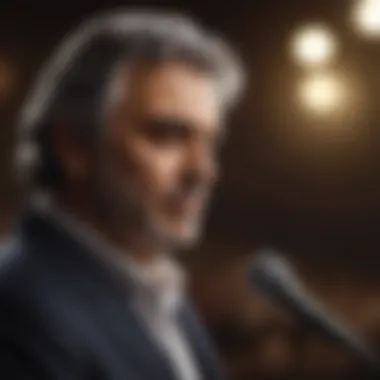
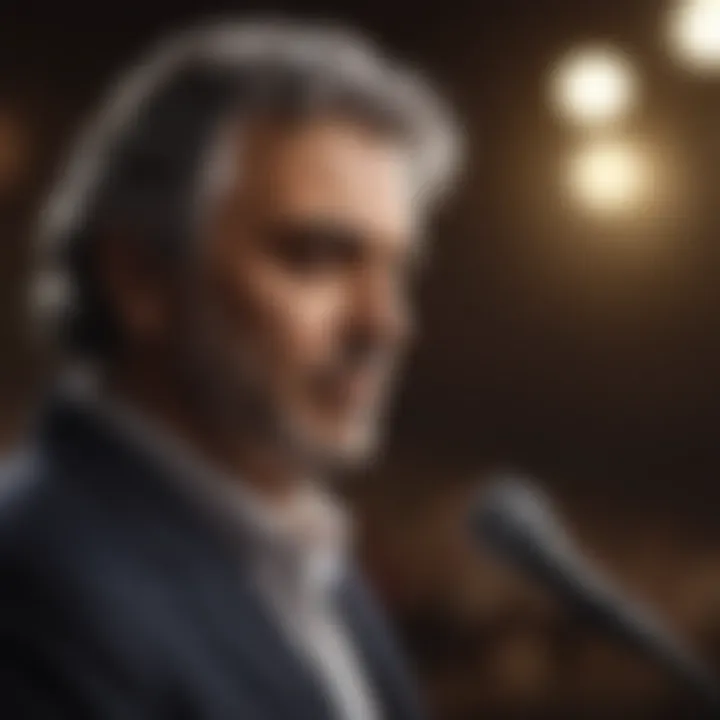
In addition, Bocelli has performed alongside artists like Michael Bublé and Ariana Grande, each duet emphasized Bocelli’s ability to adapt and thrive within diverse musical environments. These collaborations not only highlight his skill but also reinforce his position as a central figure in the music industry.
Influence of Classical Composers
Many of Bocelli’s most significant performances have been influenced by classical composers. His frequent nods to the masters illustrate an understanding and appreciation that goes beyond mere vocal execution. For instance, when he performs "Nessun dorma" from Puccini's Turandot, he doesn’t just sing; he embodies the character, telling a story that echoes the dramatic tensions and triumphs woven into the original score.
As a testament to his commitment, Bocelli often explores the more contemporary adaptations of classical works. His interpretations breathe fresh air into classical pieces, welcoming new audiences without forsaking the rich traditions that define them. This blend of reverence for classical foundations alongside modern sensibilities creates performances that resonate deeply with both purists and newcomers alike.
This interplay illustrates a comprehensive understanding of music that allows listeners to connect emotionally with the pieces. Thus, Bocelli does not merely sing the notes; he presents the emotional journey that these composers had envisioned. Whether on stage or in recordings, the influence of these composers textures each performance, adding layers of significance and depth.
In summary, the collaborations with renowned artists and the influence of classical composers define Bocelli's career trajectory. They serve to enrich his narrative as an artist, making him not just a performer but an ambassador of music across generations.
Cultural Impact of Bocelli's Performances
The cultural impact of Andrea Bocelli's performances extends far beyond merely captivating audiences. It intertwines his artistry with broader conversations about music, identity, and community. Bocelli’s unique ability to bridge classical and contemporary music, while simultaneously reaching out to diverse audiences, positions him as a pivotal figure in the modern musical landscape. His performances serve as a lens through which one can examine the evolving relationship between classical music and the masses, and how such connections foster understanding and appreciation across various demographics.
Connecting with Diverse Audiences
Bocelli has an uncanny knack for making classical music accessible to those who may never have encountered it in traditional settings. His performances often emphasize a human connection, drawing in people from all walks of life. Whether it’s a grand opera house or an outdoor venue filled with thousands, Bocelli’s voice resonates, evoking emotions that are universal.
The choice of repertoire plays a significant role. By blending familiar pop melodies with classical staples, he manages to cater to a spectrum of tastes. Many find that his interpretations bring a fresh perspective to well-known pieces, thereby introducing them to a new audience. Songs like "Time to Say Goodbye" have transcended cultural boundaries, allowing that emotional connection to be felt by anyone, regardless of background.
Moreover, Bocelli’s visibility in international events and collaborations with popular artists has propelled his reach further. From the stunning Teatro del Silenzio performances to sharing the stage with the likes of Ed Sheeran or Michael Bublé, he turns each concert into a collective experience rather than a mere showcase of talent.
"In each note, Bocelli tells a story that resonates with everyone; it’s as if he holds a mirror up to our own emotions."
Bocelli as a Global Ambassador of Music
Andrea Bocelli’s role as a global ambassador of music encompasses more than just his international tours. His music becomes a symbol of hope and resilience in challenging times. The blending of genres he exhibits not only showcases his versatility but also sends a message of inclusivity. With each performance broadcast worldwide, he offers a melodic escape that transcends linguistic and cultural barriers.
His humanitarian work further cements this title. Often, he participates in concerts for charitable causes, merging his musical presence with the advocacy for social issues. For instance, performances in support of UNICEF or during benefit concerts highlight his commitment to giving back. By using his platform to raise awareness and funds, Bocelli transforms his artistry into a tool for change.
The cultural relevance of Bocelli’s work is not just in the music he creates but in the conversations and connections that arise from it. Through his talent and philanthropic efforts, he advocates for a world united by the beauty of music, reflecting the profound impact it can have on global unity and understanding.
The Role of Emotion in Live Performances
Andrea Bocelli's live performances transcend mere vocal display; they resonate deeply with the audience, intertwining music and emotion in an unforgettable experience. The ability to convey feelings through song is paramount, and for Bocelli, this is not just a component of performance but rather the very crux of his artistry. Emotional engagement creates a connection that bridges the gap between performer and audience, making each concert not just an event, but a shared experience.
Evoking Strong Reactions from the Audience
When Bocelli takes the stage, it's as if time stands still. Each note is laced with a palpable intensity that stirs the hearts of listeners. His uniquely powerful voice can tumble from soaring heights to fragile whispers, crafting an emotional landscape that pulls at the heartstrings.
- Storytelling Through Song: Bocelli's choice of repertoire is deliberate, often weaving through themes of love, loss, and hope. Whether he is belting out a passionate aria or gently crooning a romantic ballad, he invites the audience to experience the story behind the lyrics.
- Body Language and Stage Presence: It’s not only the voice that casts a spell; Bocelli’s physical presence on stage amplifies the emotional atmosphere. Subtle gestures, intentional expressions, and an open stance create a profound communication channel, transforming the performance into a dialogue with fans—a connection that speaks louder than words.
"The greatest impact of music is not merely its sound; it is the extent to which it touches the soul and echoes within us long after the final note has faded."
The Healing Power of Music
Bocelli’s performances seem to possess a healing quality, often invoked by the sheer emotion of the music. For many attendees, the experience is cathartic—allowing them to confront personal struggles, find solace, or simply escape the grind of daily life, even if just for a moment.
- Music as Therapy: Numerous studies indicate that listening to music can reduce stress, alleviate depression, and even help in the healing process of various ailments. Bocelli, through his commanding performances, inadvertently acts as a vessel for this therapeutic quality, allowing his audience to experience an emotional release.
- Community and Connection: Concerts are often communal events where shared experiences can lead to healing. The collective energy in the audience, as they sing along or indulge in the silence of a poignant moment, fosters a sense of belonging. Bocelli’s songs often call forth a collective nostalgia, where individual stories interweave to form a larger narrative of shared human experience.
In a world where one can feel isolated, Bocelli’s music acts as a reminder of our shared humanity, demonstrating how powerful emotional expression in live performances can be. Through the blend of heartfelt emotion and exceptional musicality, he ushers us into a realm where every note is charged with feeling and every concert turns into a testament of the enduring power of music.
Critique of Bocelli's Musical Journey
The exploration of Andrea Bocelli's musical journey offers a multifaceted perspective on an artist who has traversed diverse landscapes of music. Analyzing the critique surrounding his work is crucial for a better understanding of how Bocelli has navigated the complex world of modern music. Critics, both harsh and kind, have examined different aspects, from his vocal prowess to his ability to straddle genres. This lens provides insights into the nuances of his artistry, heightening awareness of the ongoing dialogue between an artist and their audience.
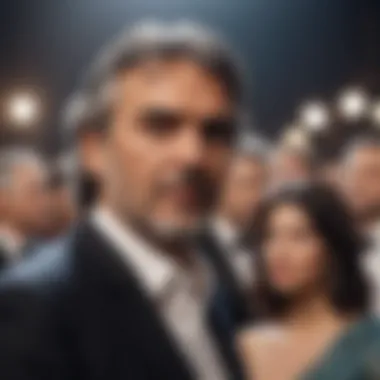
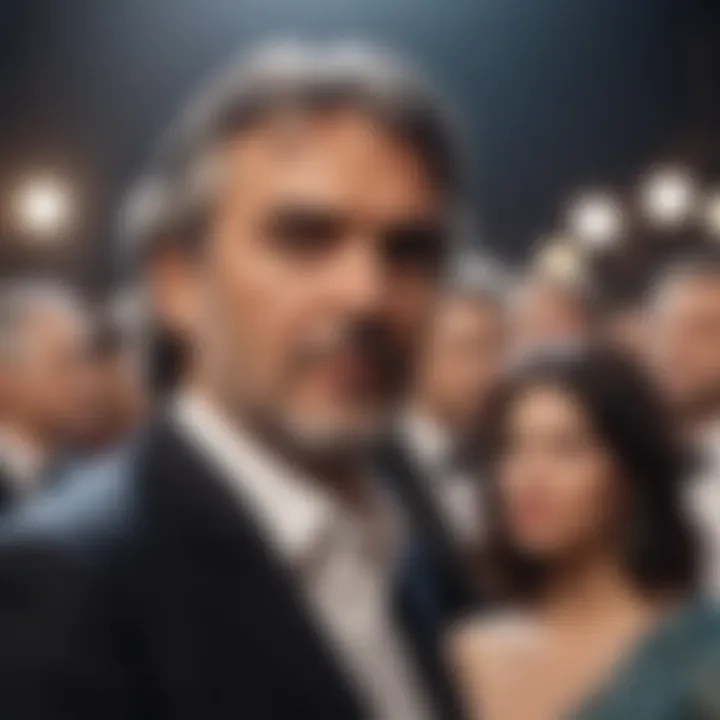
Reception by Critics and Music Professionals
Bocelli's entrance into the music realm was not without scrutiny. The initial reception from critiques was mixed, predominantly due to his crossover approach which tinged classical melodies with popular elements. Some music professionals embraced this blend, seeing it as a gateway for broader audiences to appreciate classical music. Others, however, felt that Bocelli diluted traditional operatic standards in pursuit of mainstream appeal.
When we consider the comments made by reputable critics, some laud his remarkable vocal technique. For instance, his ability to execute intricate arias with emotional depth stands out, earning him respect among classical aficionados. Nonetheless, detractors argue that Bocelli's sometimes simplistic lyrical choices can overshadow his immense talent. This clash of opinions has become a defining characteristic of his artistic identity.
Moreover, music professionals have analyzed Bocelli’s technical abilities and stage presence. His command over the operatic repertoire is typically praised, alongside his graceful poise during live performances. Some industry insiders mention that Bocelli’s willingness to engage in varied musical styles showcases a duty to connect with a wider audience. Yet, the expectation to maintain operatic integrity often weighs heavily on him, reflecting an ongoing debate within the musical community.
Fan Perspectives and Community Support
From the perspective of fans, Andrea Bocelli embodies an artist who resonates with many people. His ability to bridge the gap between classical and pop is something that sets him apart; it's like he knows how to speak to the heart. Many fans express admiration not only for his voice but also for his personal story, as overcoming adversity has become a vital part of his narrative.
Online forums and social media platforms exhibit a passionate community that supports Bocelli. On Reddit, for example, users frequently share concert experiences, highlighting breathtaking moments during live performances that moved them. The emotional connection is palpable, as many fans report feeling uplifted, healed, or inspired by Bocelli's music.
Additionally, fan support extends beyond just the listening experience. They actively promote his work, engaging in discussions about his latest albums, tours, and performances. These communities can even be viewed as networks of support, standing together to defend his artistic choices against any negative critiques. A strong camaraderie exists, reminding us that music has the unique power to unite diverse groups of individuals.
"Andrea Bocelli is not just a singer; he is a vial to connect with human emotions, beautifully wrapped in melody."
In summary, the critique of Andrea Bocelli's musical journey reveals a landscape filled with differing opinions. While critics analyze and challenge his choices, fans celebrate the emotional depth and personal connection his music fosters. The push and pull between these perspectives not only enrich understanding of his art but also reflect the broader conversation surrounding contemporary music's evolution.
Future Directions in Bocelli's Performances
The performances of Andrea Bocelli represent a continually evolving journey, where each concert and album serves as a step in his artistic growth. As we look ahead, it's critical to consider how Bocelli might explore new avenues within his career. This exploration not only affects his artistry but also impacts his fan base, the music industry, and indeed, the cultural fabric of contemporary music. By recognizing the potential directions for Bocelli’s performances, one can appreciate the layers of innovation that await in his future endeavors.
Exploring New Musical Frontiers
Bocelli has always been an artist willing to blend styles, stepping out of boundaries traditionally drawn by the genres of classical and pop. In the years to come, one can expect him to take even bolder leaps into various musical landscapes. Collaborating with genres like jazz or electronic could add exciting dimensions to his rich sound.
Given his impressive vocal range and emotive storytelling, there’s real potential for him to capture the essence of different cultures through their unique musical styles. Imagine him integrating elements of traditional Brazilian bossa nova or the intricate rhythms of African drumming into his performances. Such ventures could not only offer his audience fresh sonic experiences but also deepen the connection between his music and global cultures.
Furthermore, advancements in technology have begun to play a more significant role in live performances. Artists are now exploring immersive experiences that blend visuals with music through augmented and virtual reality. Bocelli’s already theatrical stage presence could be amplified through these innovative technologies, enabling audiences to engage with his performances in entirely new ways.
Anticipations from Upcoming Tours and Projects
As fans eagerly await Bocelli’s future tours and projects, the anticipation is palpable. It’s a unique moment for concert-goers and music lovers alike, as Bocelli has a way of making every performance feel special and personal. His upcoming tours could potentially reflect his willingness to experiment and push artistic boundaries.
There are whispers of collaborations with contemporary artists, which could lead to unique blends of musical styles. This cross-pollination may see Bocelli not only continue to work within the classical crossover genre but also develop new partnerships that bring forth fresh material.
"Anticipating Bocelli's next moves is like waiting for a skilled painter to unveil their masterpiece. Each stroke is deliberate, and the unveiling reveals layers of depth and emotion."
Moreover, integrating audience interaction during performances might also become a part of Bocelli’s repertoire. Imagine a concert where the audience votes on which songs should be performed or contributing their own interpretations of pieces through social media platforms like Facebook or discussions on forums like Reddit. Such involvement would not only strengthen the connection between Bocelli and his fans but also make each performance a collective experience.
As Bocelli charts his course into the future, one thing remains certain: his performances will continue to resonate, inspire, and connect with people around the world.
Ending: The Enduring Legacy of Andrea Bocelli
In the realm of contemporary music, Andrea Bocelli stands as a beacon, his work transcending mere performance to create an enduring legacy. This section encapsulates his influence, weaving together themes of artistry, dedication, and cultural significance that resonate not just within the walls of concert halls, but across global landscapes. Bocelli’s impact is manifested not only through his multiple chart-topping albums but also through the emotional connections he fosters with his audience.
Summarizing Bocelli's Influence on Music
Andrea Bocelli has fundamentally reshaped the expectations surrounding classical crossover music. By merging operatic nuances with mainstream appeal, he has opened doors for many aspiring musicians. His powerful tenor voice, combined with his passion for storytelling through song, offers listeners a unique experience that captures both the heart and the mind. Here are some key aspects of his influence:
- Accessibility of Classical Music: Bocelli's performances make classical music more accessible to a broader audience. His collaborations with pop artists bridge the gap between genres, inviting those who may not typically engage with opera to explore its depths.
- Cultural Exchange: Through his concerts around the world, Bocelli not only showcases his Italian heritage but also invites cross-cultural dialogues, allowing audiences to appreciate music in its various forms.
- Inspiration for New Generations: Young singers look up to Bocelli as a role model. His story—from a small town in Italy to international stardom—serves as a motivation for aspiring musicians striving to make their mark in a competitive industry.
"Music touches the soul in ways that words often cannot express; Bocelli’s artistry ensures that countless souls around the world feel understood."
Reflections on His Continuing Relevance
Although Bocelli has been in the spotlight for decades, his relevance in today's music landscape remains robust. This can be attributed to several factors:
- Diverse Repertoire: Bocelli continually expands his repertoire, exploring different musical styles while retaining the emotional core of his classic training. His willingness to experiment keeps his sound fresh and engaging.
- Engagement with Global Issues: Many of his recent performances reflect societal issues, from promoting peace through music to supporting health initiatives. His ability to harness his platform for greater causes ensures his position as not just an artist, but an advocate.
- Emotional Depth: Bocelli's performances are rich with emotion, captivating audiences across generations. His talent for conveying feelings through music creates a universal language that transcends barriers, ensuring his place in the hearts of listeners.
In summary, Andrea Bocelli’s legacy is manifested through a combination of his remarkable talent, his contributions to the arts, and a deep emotional connection he nurtures with audiences around the world. As his journey continues, there is little doubt that he will keep enthralling us—both now and in the future.







